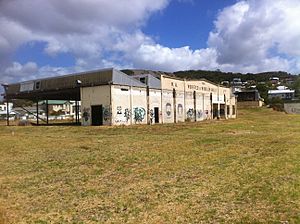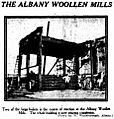Albany Woollen Mills facts for kids
The Albany Woollen Mills was a large factory in Albany, Western Australia, that made products from wool. It was also known by its official name, the Western Australian Worsted and Woollen Mills Ltd. This factory was special because it was the very first woollen mill ever built in the state of Western Australia.
Contents
The Big Idea: A Mill for Albany
In 1920, people started talking about building a woollen mill in the town of Albany. An article in the Albany Advertiser newspaper said Albany would be a great spot. It had plenty of fresh water and the weather was just right for making wool products.
A local lawyer named S. G. Haynes even gave 30 acres (12 ha) of land for free to help the project get started. In 1921, a government leader named John Scaddan announced that Albany was the chosen location, beating out other towns like Perth and Bunbury.
Building the Mill
Construction on the new mill began in 1923. The leader of Western Australia at the time, Premier James Mitchell, laid the first stone of the foundation on March 7.
A company from Melbourne called L. Hinks and Company was hired to build the mill for a cost of £85,000. However, the builders decided the free land was too far from town. They bought a new piece of land right next to the railway line.
The main building was huge. It was 352 feet (107 m) long and 166 feet (51 m) wide. The walls were made of strong reinforced concrete, and the roof was held up by 60 steel posts. To power the factory, two giant 400 horsepower boilers were installed. They were connected to a tall smokestack that reached 100 feet (30 m) into the sky.
A Rocky Start
The Albany Woollen Mills officially opened in 1925. People hoped it would create jobs and help the economy of the Great Southern region. But right from the start, the company owed a lot of money to its investors.
By 1926, there were rumors that the mill was about to close down. The company's chairman, Ernest Augustus Lee Steere, had to tell the newspapers that this wasn't true.
For many of its early years, the mill struggled to make a profit. The location turned out to be a problem. The noise and smoke from the factory bothered the people in town. Also, the wool products it made were far away from the big city markets where they needed to be sold. The factory's design was also found to be inefficient, making it hard to run well.
In 1931, things got so tough that the mill had to let go of 100 workers and shut down for about six weeks. Premier Mitchell stepped in and helped the mill reopen.
Turning Things Around
After its difficult start, the mill began to do better. By 1934, it employed over 120 workers and was making much more money than before.
The 1950s were also a good time for the mill. It made a profit of £17,306 in 1953 and £24,500 in 1954. The chairman at the time, F. T. Heron, planned to keep improving the factory's machines and equipment. In 1963, the mill even won a big contract to help make 160,000 blankets for the army.
In 1970, the mill was in danger of closing again. A businessman named Robert Holmes à Court bought it and saved it. He made a deal with the government and worked hard to make the business successful again. The mill became part of his larger company, Bell Group Limited.
The Final Years
In 1988, the mill was sold to a new owner. At that time, it was the biggest independent spinning mill for carpet yarn in all of Australia, making about A$30 million a year.
By 1996, the mill was in financial trouble again. The government offered to help any company that was interested in buying it. The government hoped a new owner could turn it into a company that did more than just spin yarn, perhaps by making finished wool products right there in Albany.
Images for kids
See also
List of places on the State Register of Heritage Places in the City of Albany










